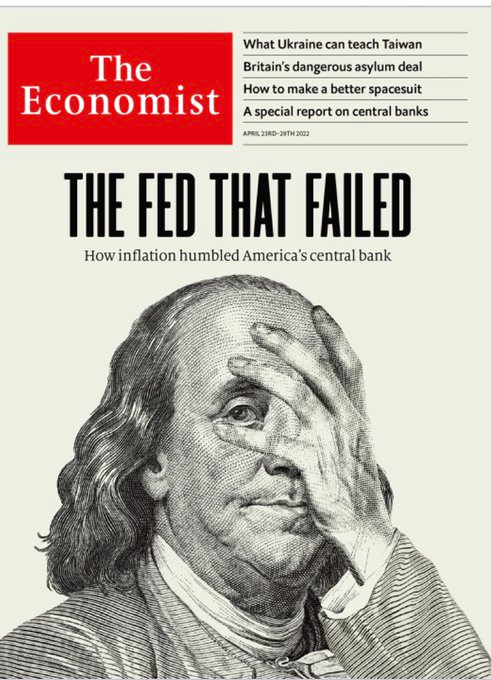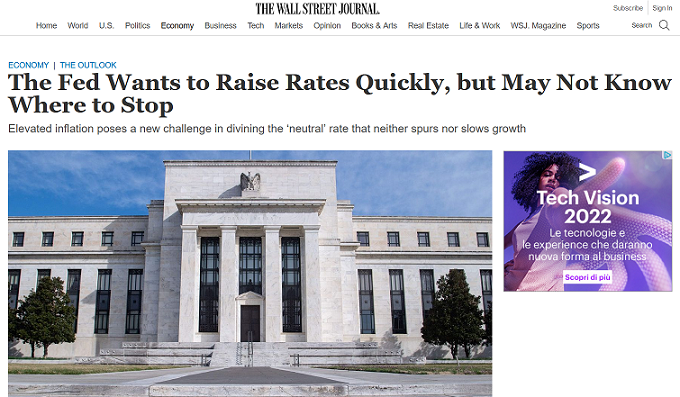La Federal Reserve del 4 maggio 2022: qual'è la "destinazione finale" di questo viaggio?
Come tutti i lettori del Blog sanno, Recce’d ha smesso di scrivere di Federal Reserve un anno e mezzo fa: in questo ultimo anno e mezzo, sarebbe stato inutile.
Questo perché la Federal Reserve, dalla seconda metà del 2020, per tutto il 2021, e in questo inizio di 2022, è rimasta non soltanto senza parole, ma pure senza strumenti, senza leve, senza armi, senza spazio di manovra. (E la BCE sta messa ancora peggio, e di molto).
E quindi, nell’ultimo anno e mezzo, la Federal Reserve non è mai stata protagonista: ha semplicemente fatto ciò che era costretta a fare, data la situazione (assurda, ai limiti del folle) che lei stessa, la Banca Centrale, aveva contribuito a creare.
Recce’d tutto ciò che aveva da dire in proposito lo aveva chiarito nella parte finale del 2020. E prima ancora, nell’agosto 2020.
E ancora molto tempo prima, pensate: nel 2015. E non in una sola occasione: leggete anche qui.
Oggi, quello che Recce’d scriveva anni fa lo trovate sulla prima pagina dei più autorevoli quotidiani e periodici.
Perché allora, proprio oggi, Recce’d torna a scrivere ai suoi lettori della Federal Reserve?
La ragione è molto semplice: perché adesso la Federal Reserve ritorna a contare. Non tanto sul piano pratico, dove le scelte della Federal Reserve potranno incidere ben poco.
Bensì sul piano della psicologia collettiva. Saranno le parole, più che gli atti, della Federal Reserve, ad incidere.
Dopo avere fatto una drammatica (ed ennesima) “svolta ad U” smentendo sé stessa poche settimane fa, quando ha riconosciuto che l’idea stessa di una “inflazione transitoria” era stata una tragica sciocchezza, adesso la Federal Reserve deve scegliere se continuare a mentire oppure se rispondere con chiarezza, concretezza e in modo esplicito alle domande che con sempre maggiore insistenza i mercati finanziari ed il pubblico dei risparmiatori e consumatori le rivolgono.
Le domande sono molte: anzi, sono decisamente troppe. La scelta della BCE e della Federal Reserve di fare per un anno e mezzo la parte del “pesce in barile” ha prodotto questo accumularsi di domande che ad oggi non hanno una risposta.
Dalla settimana prossima, potremmo vedere un cambiamento proprio da questo punto di vista: la Federal Reserve, costretta dall’urgenza dei fatti, costretta dall’evoluzione della realtà (che prevale sempre sulla fantasia delle persone, delle Banche Centrali, delle banche di investimento, e del vostro private banker, wealth manager, promotore finanziario), potrebbe decidere di cambiare modo, tono e contenuto della propria comunicazione.
Potrebbe decidere di smettere l’atteggiamento del tipo “non ho capito bene …” e passare ad una comunicazione più diretta ed esplicita, e più concreta.
Come già detto, le domande rimaste senza risposta, nell’ultimo anno e mezzo, sono moltissime. per questa ragione, Recce’d dedica in questi giorni una serie di nuovi Post a questo argomento.
Nel Post che state leggendo, attraverso la lettura di un articolo molto utile della settimana scorsa, pubblicato sul Wall Street Journal, ci occupiamo della seguente domanda: “Di quanto aumenterà il costo del denaro?”.
E’ necessario costruire uno, o più, scenari per rispondere a questa domanda, e in questo articolo ne vengono presentati alcuni.
Noi vogliamo mettere all’attenzione del nostro lettore anche la premessa di questo articolo: “Non sono tempi normali”.
Qualunque valutazione si voglia fare adesso, sia sulla “destinazione finale” dei tassi di interesse, sia sulla “destinazione finale” del vostro portafoglio in titoli, dei vostri asset finanziari, e dei vostri soldi risparmiati, deve necessariamente partire da questa premessa.
Federal Reserve Chairman Jerome Powell is shifting monetary tightening into a higher gear. His goal sounds straightforward—lift interest rates to “neutral,” a setting that neither spurs nor slows growth.
But there’s a catch: Even in normal times, no one knows where this theoretical level is. And these aren’t normal times. There are good reasons to think the ground beneath the central bank’s feet is shifting and that, after accounting for elevated inflation, neutral may be higher than officials’ recent estimates.
At their meeting next month, officials are set to approve plans to shrink their $9 trillion asset portfolio and to raise their benchmark rate by a half percentage point. They are poised to follow with another half-point in June.
“We’re going to be raising rates and getting expeditiously to levels that are more neutral, and then that are actually tightening policy if that turns out to be appropriate, once we get there,” Mr. Powell said during a panel discussion last week.
Key to that strategy will be estimates of the neutral interest rate, a monetary nirvana that balances supply and demand when unemployment is low, the economy is growing steadily, and inflation is stable around the Fed’s 2% objective.
“The Fed only knows where neutral is in retrospect,” said Steven Blitz, chief U.S. economist at research firm TS Lombard.
The nominal neutral rate is arrived at by adding inflation to the inflation-adjusted or real neutral rate. It is real, not nominal, rates that matter for monetary policy.
Because inflation reduces the burden of paying back debt, a positive real rate is necessary to create an incentive to save and a disincentive to borrow, such as for a home or business, thereby slowing economic growth and cooling inflation pressure.
Before the 2008 financial crisis, the nominal neutral rate was widely estimated to be near 4%—a real neutral rate of 2% plus inflation of 2%. Over the subsequent decade Fed officials lowered their estimate of neutral to between 2% and 3% because they thought the real neutral rate needed to keep both growth and inflation stable had dropped.
Officials still think the real neutral rate is low; the question is whether inflation will end up higher than 2%, which would mean a higher nominal neutral rate. If inflation settles out closer to 3%, for example, the nominal neutral rate would be closer to 3.5% than 2.5%, and the Fed might need to raise rates to 4% to actually slow the economy down.
A source of uncertainty is where neutral really is. That depends on where inflation settles out, partly based on factors outside the Fed’s control.
This confronts Fed officials with several questions: How fast to get to neutral; do rates need to go above neutral; and where is neutral?
At present, most think neutral is around 2.25% or 2.5% and rates should get there this year, at which point they can see how the economy responds. Some want to go faster, pushing rates into restrictive territory this year. Others are open to that possibility in 2023.
“I’m optimistic that we can get to neutral, look around, and find that we’re not necessarily that far from where we need to go,” said Chicago Fed President Charles Evans on April 7. By last week, though, he was a little more circumspect: “Probably we are going beyond neutral—that’s my expectation.”
A major source of uncertainty in these scenarios centers on where neutral really is. That depends on where inflation settles out, which partly is based on factors outside of the central bank’s control such as supply chain disruptions from the war in Ukraine and Covid lockdowns in China.
Federal Reserve Chairman Jerome Powell indicated on Thursday that the central bank was likely to raise interest rates by a half percentage point at its meeting in May. Photo: Samuel Corum/Getty Images
Mr. Blitz said the Fed today may find itself in a situation similar to 1978, when it was raising rates aggressively but failing to push real rates up enough to slow the economy.
“They kept thinking, ‘This is enough. This is enough.’ It kept turning out it wasn’t enough,” he said. Today, “the Fed has a lot of catching up to do to tighten financial conditions if the world is not going to come to its rescue.”
In projections released in March, most Fed officials mapped out a cheery scenario in which they raised rates to a roughly neutral rate of around 2.75% by next year. They projected growth over the next three years remains above its 1.8% long-run rate while unemployment holds below the 4% rate officials estimate is consistent with stable prices.
But those projections assume inflation, now above 5% based on the Fed’s preferred index, will revert to a long-run underlying trend rate of 2% without higher unemployment, which has historically been rare.
“The odds of doing what they projected in March are small—maybe 25%,” said Donald Kohn, a former Fed vice chairman.
John Roberts, a former Fed economist who retired last year, laid out two other scenarios in a recent analysis. Under one, the Fed raises rates to nearly 2.5% this year and to 4.25% next year, which brings inflation down to 2.5% by 2025. That would push the unemployment rate up by magnitudes that have only occurred during recessions.
In the other, high inflation through 2022 changes underlying consumer psychology, causing underlying inflation to rise, and the Fed fails to raise rates sufficiently to counteract that, leaving inflation persistently above 3% for the rest of the decade.
The bond market has faced a brutal selloff over the last two months, pushing yields sharply higher, as the Fed promises tighter policy. It could be in for another blow if central bank officials publicly conclude that interest rates need to go even higher than currently anticipated in 2023.
Write to Nick Timiraos at nick.timiraos@wsj.com
Appeared in the April 25, 2022, print edition as '‘Neutral’ Fed Rate Is a Moving Target.



